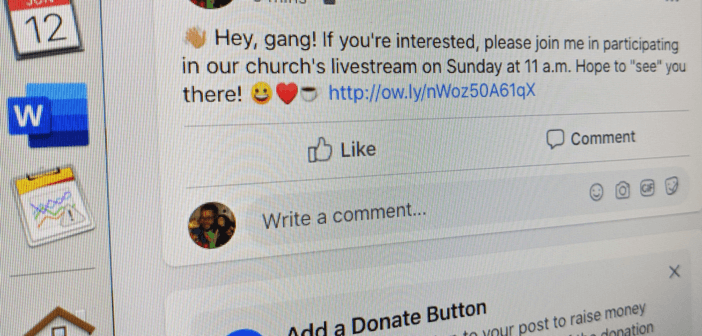One apparent advantage of an online worship format is that people seem to be more inclined to extend and respond to invitations to check out church online. Virtual evangelism is proving easier, less intimidating, and more spontaneous than face-to-face evangelism.
This article is also available in Korean. 한국어 버전
Anecdotal evidence suggests that worship attendance has increased rather significantly for many congregations that are now worshipping online in comparison to their previous in-person attendance. Many factors are likely contributing to this rise. But one may be the ease and comfort of “virtual evangelism.”
Many church members feel uncomfortable inviting friends to come to in-person church. Some may even feel uncomfortable divulging that they attend church at all. But using social media to share enthusiasm for a church’s online worship seems to be more intuitive and natural. And extending a virtual invitation is not only easy, it is also more comfortable. It probably doesn’t feel quite as “in your face” and it removes the immediate fear of rejection. For those who do not normally attend church, online church is more visible and present to them than what goes on behind closed doors on Sunday mornings. And they can explore faith without fear of ridicule or judgment and without the intimidating experience of walking into a room full of unfamiliar faces.
It is hard to draw firm conclusions based on what has been for many congregations a brief and novel sojourn into the realm of online church. But it appears that many find virtual evangelism easier and more spontaneous than face-to-face evangelism. Here are some ideas for encouraging virtual evangelism in your congregation.
Post sermons on social media
The simplest option is posting links to sermons or worship experiences to social media platforms. People can share the post and comment briefly about how the sermon impacted them or mention something that touched them in the worship experience. This simple act of posting has the potential to reach more people in an hour than face-to-face evangelism might reach in a year. And for many people, simply posting or sharing something isn’t nearly as scary as starting a conversation about God or the church.
Invite friends to worship online
Intentionally crafting an invitation on various social media platforms asking others to participate in a live stream or Sunday experience is a step up from just posting on social media. A message as simple as “join me in participating in our livestream on Sunday at 10 a.m.” can suffice. This type of social media invitation reaches many more people than inviting one person at a time. And the invitation can be made without putting anyone on the spot or having to worry about how a particular person will react.
Share what the congregation is doing
Many congregations are learning that ministry is still possible even amid the restrictions of the pandemic. Sharing what your congregation is doing to transform lives and how others can safely participate can be another connection point. If your congregation needs volunteers to safely pack or hand out food during this crisis, this could be a low-barrier connection point for individuals who may otherwise have no clue how your church is serving the community.
Host a watch party
Inviting someone to view a livestream with you gets a step closer to a face-to-face invitation. The advantage of a watch party is that it allows you as host to walk through what is happening and to answer questions if your guest is unfamiliar with your church. And it allows your guest to experience worship in smaller, more personal setting. The disadvantage is that it poses the same risk of rejection as a face-to-face invitation. This may be a second step to take when you have learned that someone accepted your general invitation to participate online.
It may be that the apparent enthusiasm for sharing online church will subside once the novelty wears off or the crisis subsides. But we hope it doesn’t, because this easy, low-barrier way of sharing has the potential to accomplish more in a week than a year’s worth of “Bring-a-Friend Sundays.” And it requires considerably less investment and anxiety.
Related Resources
- Digital Church Is Here to Stay by Carey Nieuwhof
- Online Church is Your New Front Door by Carey Nieuwhof







